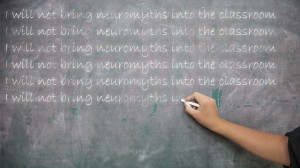Teachers and parents have a great enthusiasm for the brain sciences and the light they can shed on children’s and adults’ learning in educational environments. We share that enthusiasm at the CEN.
However, we also believe that sometimes this enthusiasm can lead to educators too readily accepting teaching practices, ideas, or techniques that do not actually have a scientific basis in neuroscience – or which reflect some basis in neuroscience but have not been rigorously tested within an educational context. This phenomenon has been labelled the spread of ‘neuromyths’ – mistaken ideas about the brain – and it has been the topic of discussion by researchers within neuroscience (e.g., articles by Goswami and Howard-Jones, see this report from the Royal Society).
Researchers in educational neuroscience have begun to compile sets of resources, meta-analyses and reviews to address which neuroscience-inspired teaching techniques are supported by empirical evidence, and which ‘facts’ about the brain actually reflect current consensus within neuroscience. In the following pages, we provide access to some of these resources, themed around some of the main topics where neuromyths have arisen, and give brief overviews about the existing state of research – what we know and don’t yet know on these topics.
Are these ‘neuro-hits’ or ‘neuro-myths’?
UPDATED 2023: We have been updating our articles to include evidence from the most recent research on each topic, indicated by the “Updated” tag below. Note that for most of the articles, an update does not mean a change in the overall conclusion (hit or myth).
- Left brain versus right brain thinkers
- UPDATED! Diet makes a difference to learning
- Fish oils improve learning
- Physical exercise enhances learning
- UPDATED! Different children have different learning styles
- UPDATED! Learning two languages gives a cognitive advantage
- UPDATED! Girls and boys have different cognitive abilities
- Most learning happens in the first 3 years of life
- Violent video games make children more violent
- We only use 10% of our brains
- UPDATED! Well-rested children do better at school
- You can train your brain with digital media
- Children do better in school if they were born in the autumn
- UPDATED! Is the number of children with ADHD in UK schools increasing?
- UPDATED! Mindfulness has a place in the classroom
- Intelligence is fixed
- The future of education is brain stimulation
![]() The CEN has launched a new project, called NeuroSENse, to explore people’s beliefs about the brain and people with special educational needs (SEN). We’d love your help in completing a short questionnaire (all answers confidential and anonymous). Click on this link to take the survey: https://uclioe.eu.qualtrics.com/jfe/form/SV_d4EceZ2McQQFaKh. Thanks!
The CEN has launched a new project, called NeuroSENse, to explore people’s beliefs about the brain and people with special educational needs (SEN). We’d love your help in completing a short questionnaire (all answers confidential and anonymous). Click on this link to take the survey: https://uclioe.eu.qualtrics.com/jfe/form/SV_d4EceZ2McQQFaKh. Thanks!
These articles were compiled by Dr. Victoria Knowland and edited by Professor Michael Thomas © CEN. This work was supported by a Wellcome Trust Institutional Strategic Support Fund grant awarded to Professor Michael Thomas, Birkbeck, University of London.
For other education and neuroscience activities sponsored by the Wellcome Trust, see:



Great work you are doing here. As a teacher of 16 years, I have long been dismayed by the dogmatic nonsense that gets pushed down on us by teaching colleges and consultants who are disconnected from real educational psychology and neuro-science, and indeed rigorous evidence in general. It is high time the myths were dealt with and we focused more on the simple things like a good nights sleep, good food, and attitude !
Thank you for this useful roundup of hits and myths. I will be using it to prompt discussion in my teaching classes.
Oh my goodness, the number of teacher who failed their observations because they couldn’t cater to different learning styles I’m a great believes in research but it’s sad to see it implemented and generalised without giving it time to be actually proved by a wide number of studies.
I’m a great believes in research but it’s sad to see it implemented and generalised without giving it time to be actually proved by a wide number of studies.
Thanks so much for developing this resource! I have been using it for the past 3 years in my advanced Ed Pych course and it is fantastic. It really helps our pre-service educators clean out the myths from their possible teaching repertoire.